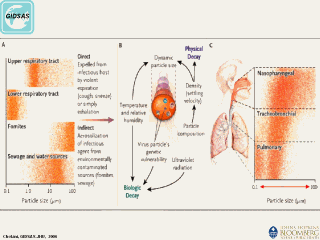 |
Whether it is an infected human or a
contaminated environmental matrix, each source (Panel A) generates particles
with a characteristic range of sizes. The length of time a particle resides
in the air (physical decay, Panel B) depends on its initial size, its
composition, and environmental factors. Similarly, the length of time an
airborne organism remains infectious (biologic decay) is affected by the
infectious agent's initial metabolic state, genetic characteristics, and
environment. The portion of the respiratory tract of a susceptible host in
which inhaled particles are deposited (Panel C) is a function of the
particles' aerodynamic size; in the middle of the range, particles may be
deposited in both the upper and the lower airways.
|
